Financial and Economic Literacy for Managers - Assignment Report
VerifiedAdded on 2020/11/12
|15
|3335
|112
Report
AI Summary
This report delves into the essential concepts of financial and economic literacy for managers, encompassing various aspects of business economics, policies, and financial analysis. It initiates with an examination of the structure-conduct-performance paradigm, growth strategies, and globalization. The report then explores demand and supply dynamics, consumer behaviour, and opportunity costs, followed by an analysis of environmental, fiscal, and supply-side policies. Furthermore, it addresses financial intermediation, instruments, and risk-return considerations. The report also includes a ratio analysis of Sainsbury and concludes with the solution to a financial problem. This comprehensive analysis provides a solid foundation for understanding the financial and economic landscape relevant to managerial decision-making.
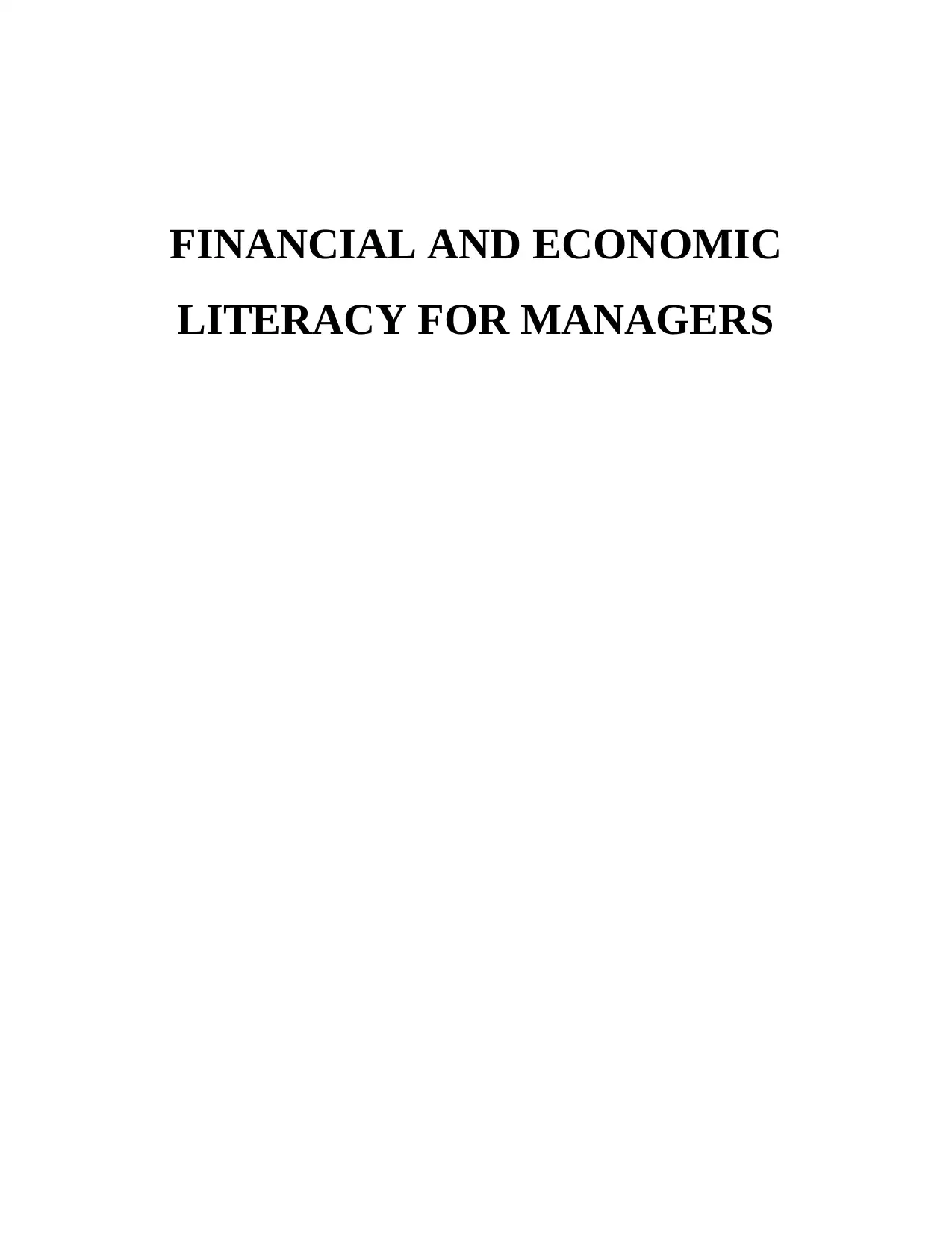
FINANCIAL AND ECONOMIC
LITERACY FOR MANAGERS
LITERACY FOR MANAGERS
Paraphrase This Document
Need a fresh take? Get an instant paraphrase of this document with our AI Paraphraser
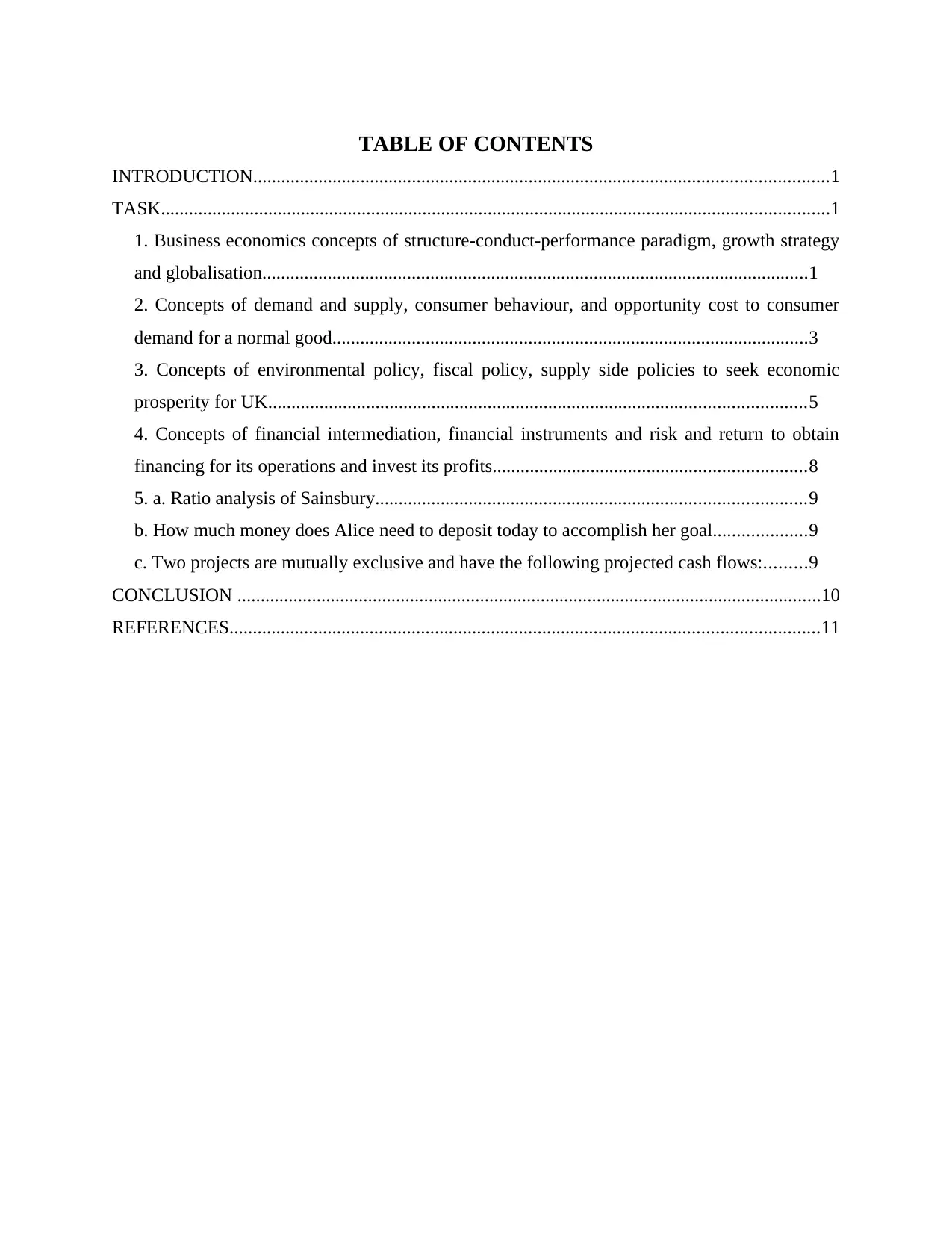
TABLE OF CONTENTS
INTRODUCTION...........................................................................................................................1
TASK...............................................................................................................................................1
1. Business economics concepts of structure-conduct-performance paradigm, growth strategy
and globalisation.....................................................................................................................1
2. Concepts of demand and supply, consumer behaviour, and opportunity cost to consumer
demand for a normal good......................................................................................................3
3. Concepts of environmental policy, fiscal policy, supply side policies to seek economic
prosperity for UK...................................................................................................................5
4. Concepts of financial intermediation, financial instruments and risk and return to obtain
financing for its operations and invest its profits...................................................................8
5. a. Ratio analysis of Sainsbury............................................................................................9
b. How much money does Alice need to deposit today to accomplish her goal....................9
c. Two projects are mutually exclusive and have the following projected cash flows:.........9
CONCLUSION .............................................................................................................................10
REFERENCES..............................................................................................................................11
INTRODUCTION...........................................................................................................................1
TASK...............................................................................................................................................1
1. Business economics concepts of structure-conduct-performance paradigm, growth strategy
and globalisation.....................................................................................................................1
2. Concepts of demand and supply, consumer behaviour, and opportunity cost to consumer
demand for a normal good......................................................................................................3
3. Concepts of environmental policy, fiscal policy, supply side policies to seek economic
prosperity for UK...................................................................................................................5
4. Concepts of financial intermediation, financial instruments and risk and return to obtain
financing for its operations and invest its profits...................................................................8
5. a. Ratio analysis of Sainsbury............................................................................................9
b. How much money does Alice need to deposit today to accomplish her goal....................9
c. Two projects are mutually exclusive and have the following projected cash flows:.........9
CONCLUSION .............................................................................................................................10
REFERENCES..............................................................................................................................11
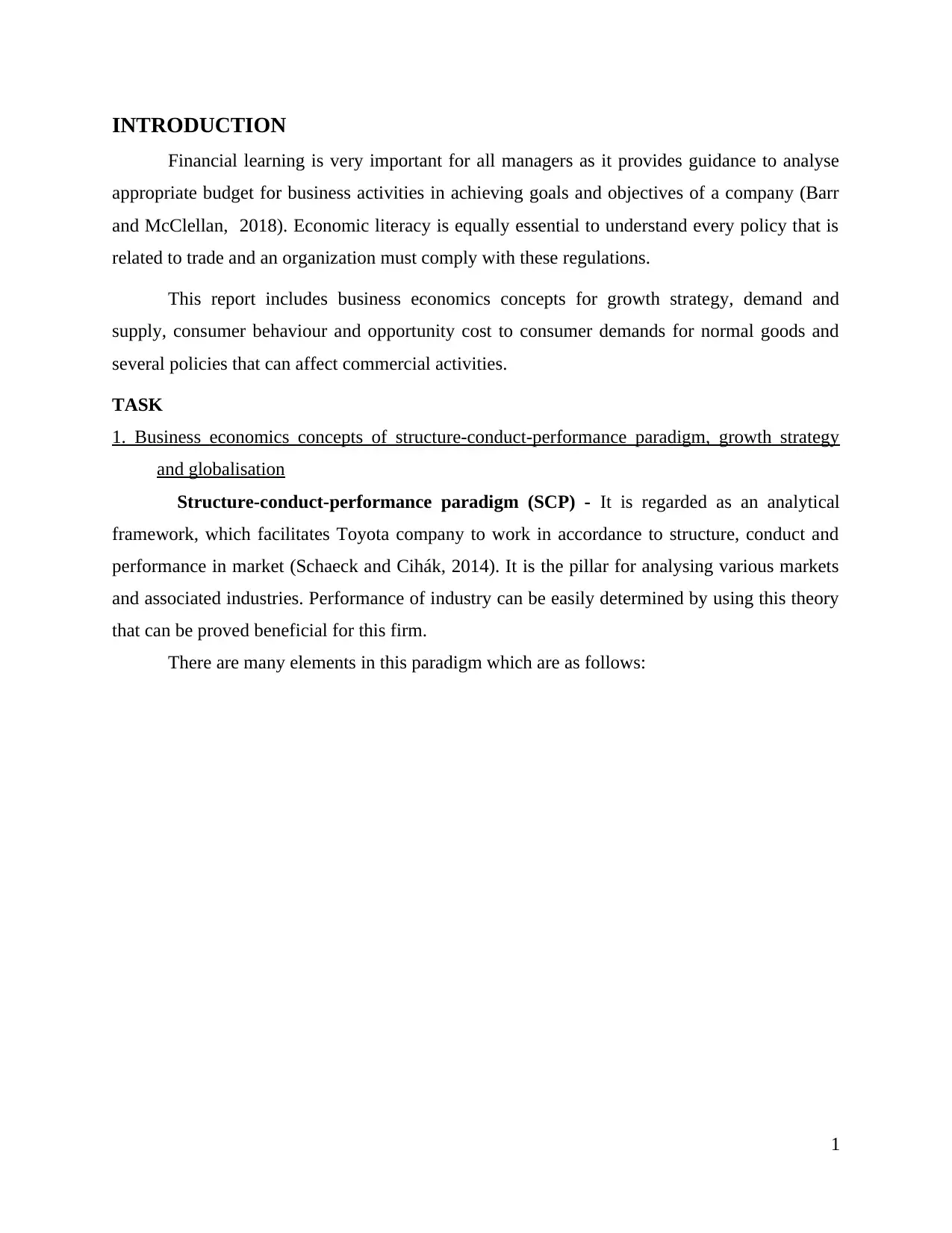
INTRODUCTION
Financial learning is very important for all managers as it provides guidance to analyse
appropriate budget for business activities in achieving goals and objectives of a company (Barr
and McClellan, 2018). Economic literacy is equally essential to understand every policy that is
related to trade and an organization must comply with these regulations.
This report includes business economics concepts for growth strategy, demand and
supply, consumer behaviour and opportunity cost to consumer demands for normal goods and
several policies that can affect commercial activities.
TASK
1. Business economics concepts of structure-conduct-performance paradigm, growth strategy
and globalisation
Structure-conduct-performance paradigm (SCP) - It is regarded as an analytical
framework, which facilitates Toyota company to work in accordance to structure, conduct and
performance in market (Schaeck and Cihák, 2014). It is the pillar for analysing various markets
and associated industries. Performance of industry can be easily determined by using this theory
that can be proved beneficial for this firm.
There are many elements in this paradigm which are as follows:
1
Financial learning is very important for all managers as it provides guidance to analyse
appropriate budget for business activities in achieving goals and objectives of a company (Barr
and McClellan, 2018). Economic literacy is equally essential to understand every policy that is
related to trade and an organization must comply with these regulations.
This report includes business economics concepts for growth strategy, demand and
supply, consumer behaviour and opportunity cost to consumer demands for normal goods and
several policies that can affect commercial activities.
TASK
1. Business economics concepts of structure-conduct-performance paradigm, growth strategy
and globalisation
Structure-conduct-performance paradigm (SCP) - It is regarded as an analytical
framework, which facilitates Toyota company to work in accordance to structure, conduct and
performance in market (Schaeck and Cihák, 2014). It is the pillar for analysing various markets
and associated industries. Performance of industry can be easily determined by using this theory
that can be proved beneficial for this firm.
There are many elements in this paradigm which are as follows:
1
⊘ This is a preview!⊘
Do you want full access?
Subscribe today to unlock all pages.

Trusted by 1+ million students worldwide
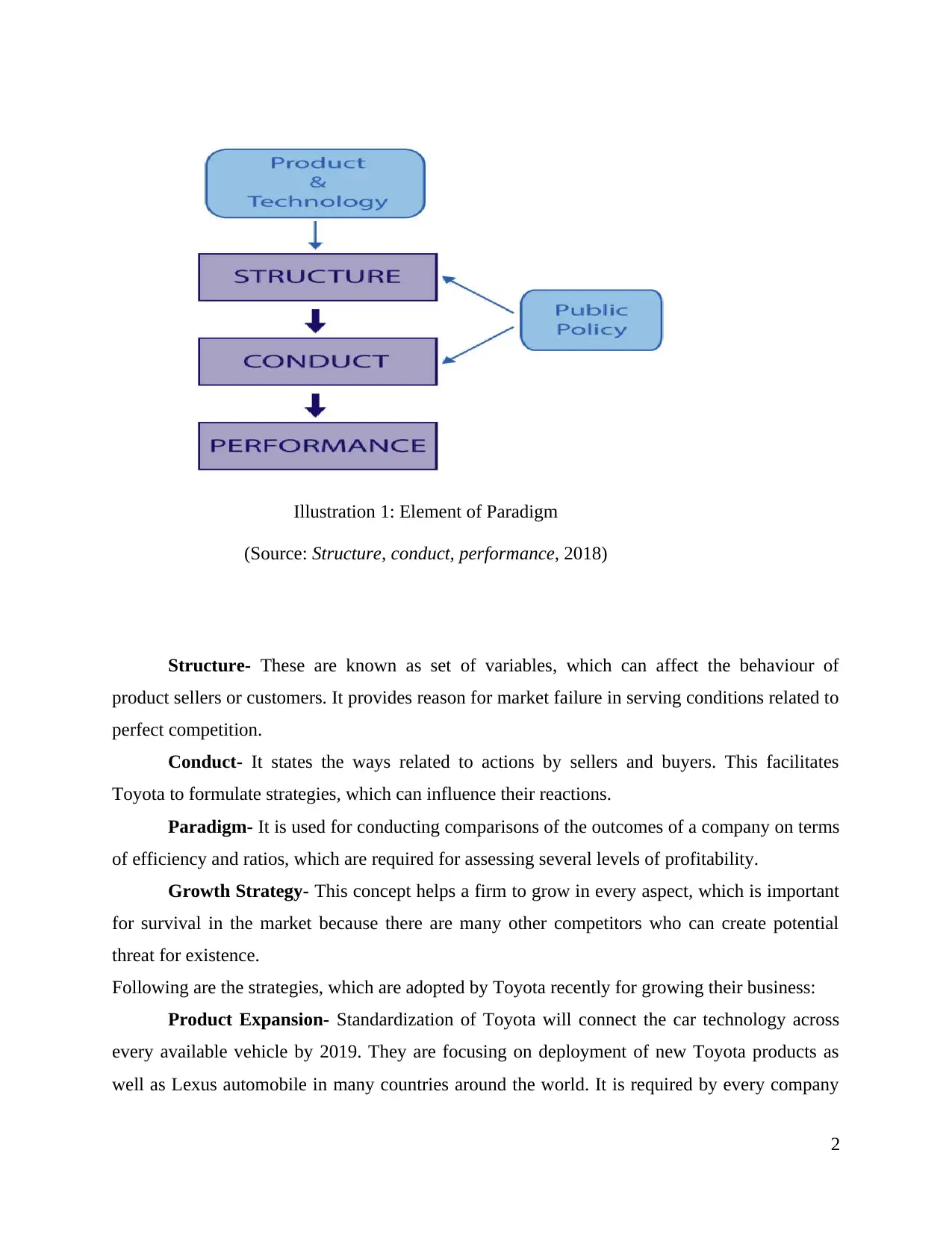
Structure- These are known as set of variables, which can affect the behaviour of
product sellers or customers. It provides reason for market failure in serving conditions related to
perfect competition.
Conduct- It states the ways related to actions by sellers and buyers. This facilitates
Toyota to formulate strategies, which can influence their reactions.
Paradigm- It is used for conducting comparisons of the outcomes of a company on terms
of efficiency and ratios, which are required for assessing several levels of profitability.
Growth Strategy- This concept helps a firm to grow in every aspect, which is important
for survival in the market because there are many other competitors who can create potential
threat for existence.
Following are the strategies, which are adopted by Toyota recently for growing their business:
Product Expansion- Standardization of Toyota will connect the car technology across
every available vehicle by 2019. They are focusing on deployment of new Toyota products as
well as Lexus automobile in many countries around the world. It is required by every company
2
Illustration 1: Element of Paradigm
(Source: Structure, conduct, performance, 2018)
product sellers or customers. It provides reason for market failure in serving conditions related to
perfect competition.
Conduct- It states the ways related to actions by sellers and buyers. This facilitates
Toyota to formulate strategies, which can influence their reactions.
Paradigm- It is used for conducting comparisons of the outcomes of a company on terms
of efficiency and ratios, which are required for assessing several levels of profitability.
Growth Strategy- This concept helps a firm to grow in every aspect, which is important
for survival in the market because there are many other competitors who can create potential
threat for existence.
Following are the strategies, which are adopted by Toyota recently for growing their business:
Product Expansion- Standardization of Toyota will connect the car technology across
every available vehicle by 2019. They are focusing on deployment of new Toyota products as
well as Lexus automobile in many countries around the world. It is required by every company
2
Illustration 1: Element of Paradigm
(Source: Structure, conduct, performance, 2018)
Paraphrase This Document
Need a fresh take? Get an instant paraphrase of this document with our AI Paraphraser
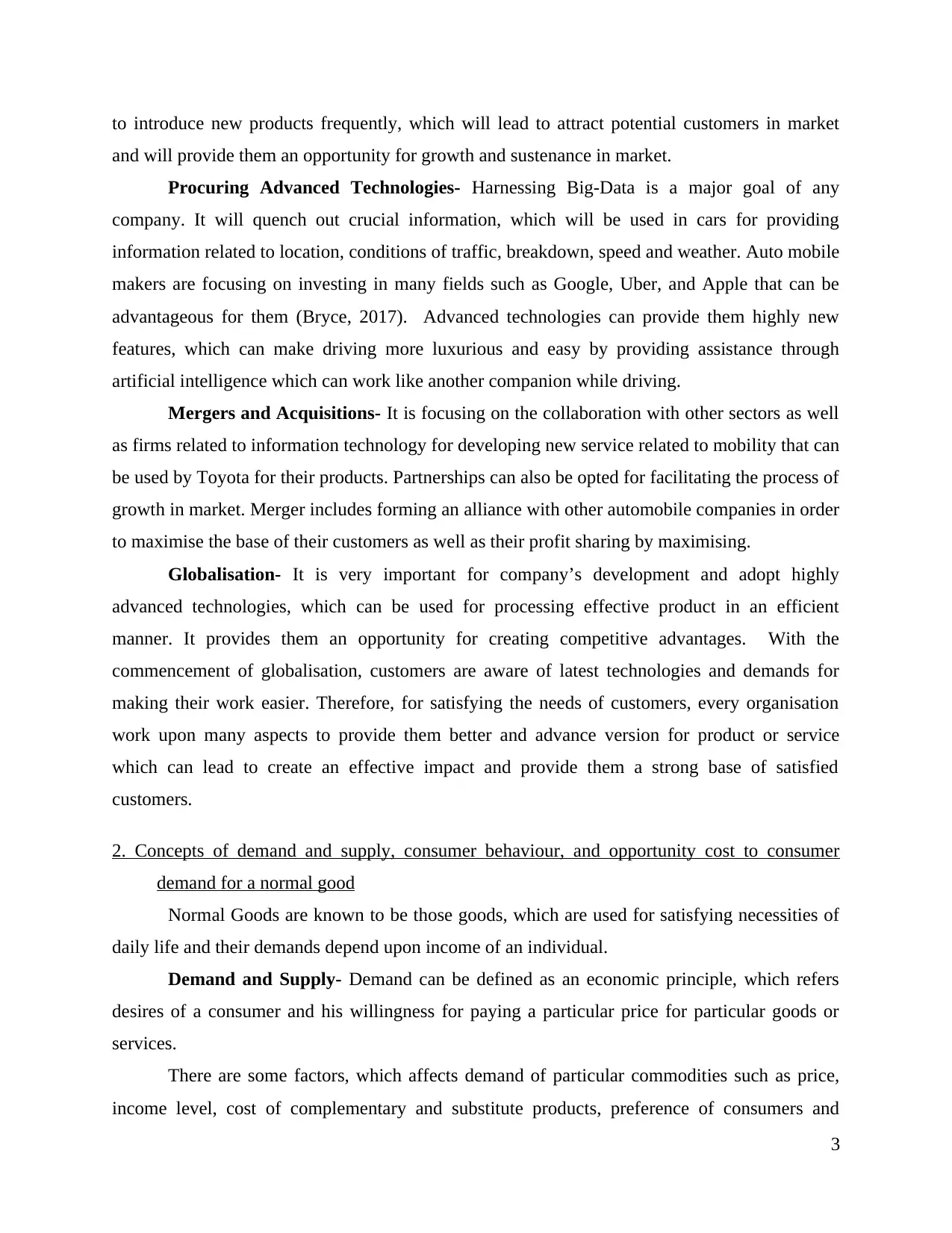
to introduce new products frequently, which will lead to attract potential customers in market
and will provide them an opportunity for growth and sustenance in market.
Procuring Advanced Technologies- Harnessing Big-Data is a major goal of any
company. It will quench out crucial information, which will be used in cars for providing
information related to location, conditions of traffic, breakdown, speed and weather. Auto mobile
makers are focusing on investing in many fields such as Google, Uber, and Apple that can be
advantageous for them (Bryce, 2017). Advanced technologies can provide them highly new
features, which can make driving more luxurious and easy by providing assistance through
artificial intelligence which can work like another companion while driving.
Mergers and Acquisitions- It is focusing on the collaboration with other sectors as well
as firms related to information technology for developing new service related to mobility that can
be used by Toyota for their products. Partnerships can also be opted for facilitating the process of
growth in market. Merger includes forming an alliance with other automobile companies in order
to maximise the base of their customers as well as their profit sharing by maximising.
Globalisation- It is very important for company’s development and adopt highly
advanced technologies, which can be used for processing effective product in an efficient
manner. It provides them an opportunity for creating competitive advantages. With the
commencement of globalisation, customers are aware of latest technologies and demands for
making their work easier. Therefore, for satisfying the needs of customers, every organisation
work upon many aspects to provide them better and advance version for product or service
which can lead to create an effective impact and provide them a strong base of satisfied
customers.
2. Concepts of demand and supply, consumer behaviour, and opportunity cost to consumer
demand for a normal good
Normal Goods are known to be those goods, which are used for satisfying necessities of
daily life and their demands depend upon income of an individual.
Demand and Supply- Demand can be defined as an economic principle, which refers
desires of a consumer and his willingness for paying a particular price for particular goods or
services.
There are some factors, which affects demand of particular commodities such as price,
income level, cost of complementary and substitute products, preference of consumers and
3
and will provide them an opportunity for growth and sustenance in market.
Procuring Advanced Technologies- Harnessing Big-Data is a major goal of any
company. It will quench out crucial information, which will be used in cars for providing
information related to location, conditions of traffic, breakdown, speed and weather. Auto mobile
makers are focusing on investing in many fields such as Google, Uber, and Apple that can be
advantageous for them (Bryce, 2017). Advanced technologies can provide them highly new
features, which can make driving more luxurious and easy by providing assistance through
artificial intelligence which can work like another companion while driving.
Mergers and Acquisitions- It is focusing on the collaboration with other sectors as well
as firms related to information technology for developing new service related to mobility that can
be used by Toyota for their products. Partnerships can also be opted for facilitating the process of
growth in market. Merger includes forming an alliance with other automobile companies in order
to maximise the base of their customers as well as their profit sharing by maximising.
Globalisation- It is very important for company’s development and adopt highly
advanced technologies, which can be used for processing effective product in an efficient
manner. It provides them an opportunity for creating competitive advantages. With the
commencement of globalisation, customers are aware of latest technologies and demands for
making their work easier. Therefore, for satisfying the needs of customers, every organisation
work upon many aspects to provide them better and advance version for product or service
which can lead to create an effective impact and provide them a strong base of satisfied
customers.
2. Concepts of demand and supply, consumer behaviour, and opportunity cost to consumer
demand for a normal good
Normal Goods are known to be those goods, which are used for satisfying necessities of
daily life and their demands depend upon income of an individual.
Demand and Supply- Demand can be defined as an economic principle, which refers
desires of a consumer and his willingness for paying a particular price for particular goods or
services.
There are some factors, which affects demand of particular commodities such as price,
income level, cost of complementary and substitute products, preference of consumers and
3
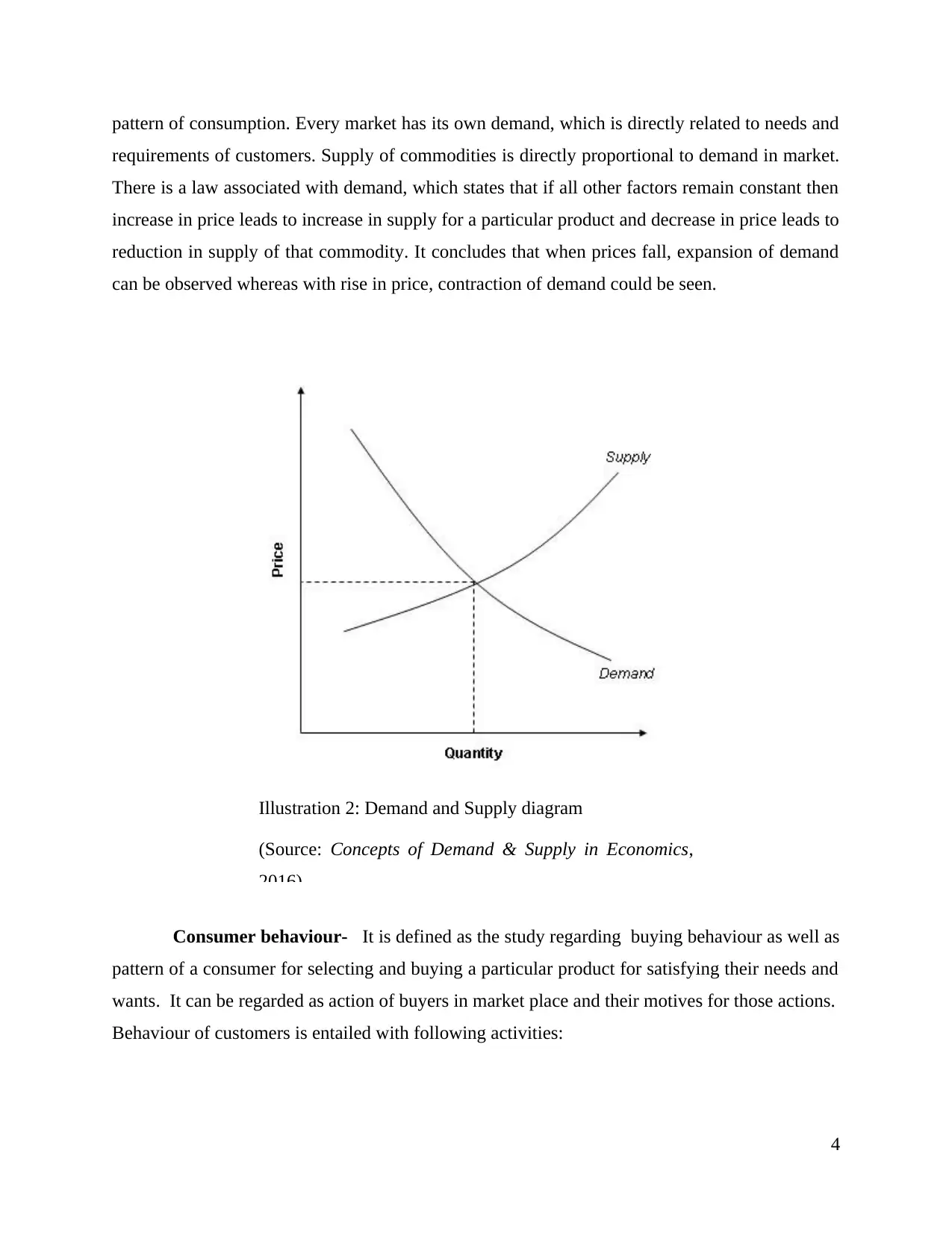
pattern of consumption. Every market has its own demand, which is directly related to needs and
requirements of customers. Supply of commodities is directly proportional to demand in market.
There is a law associated with demand, which states that if all other factors remain constant then
increase in price leads to increase in supply for a particular product and decrease in price leads to
reduction in supply of that commodity. It concludes that when prices fall, expansion of demand
can be observed whereas with rise in price, contraction of demand could be seen.
Consumer behaviour- It is defined as the study regarding buying behaviour as well as
pattern of a consumer for selecting and buying a particular product for satisfying their needs and
wants. It can be regarded as action of buyers in market place and their motives for those actions.
Behaviour of customers is entailed with following activities:
4
Illustration 2: Demand and Supply diagram
(Source: Concepts of Demand & Supply in Economics,
2016)
requirements of customers. Supply of commodities is directly proportional to demand in market.
There is a law associated with demand, which states that if all other factors remain constant then
increase in price leads to increase in supply for a particular product and decrease in price leads to
reduction in supply of that commodity. It concludes that when prices fall, expansion of demand
can be observed whereas with rise in price, contraction of demand could be seen.
Consumer behaviour- It is defined as the study regarding buying behaviour as well as
pattern of a consumer for selecting and buying a particular product for satisfying their needs and
wants. It can be regarded as action of buyers in market place and their motives for those actions.
Behaviour of customers is entailed with following activities:
4
Illustration 2: Demand and Supply diagram
(Source: Concepts of Demand & Supply in Economics,
2016)
⊘ This is a preview!⊘
Do you want full access?
Subscribe today to unlock all pages.

Trusted by 1+ million students worldwide
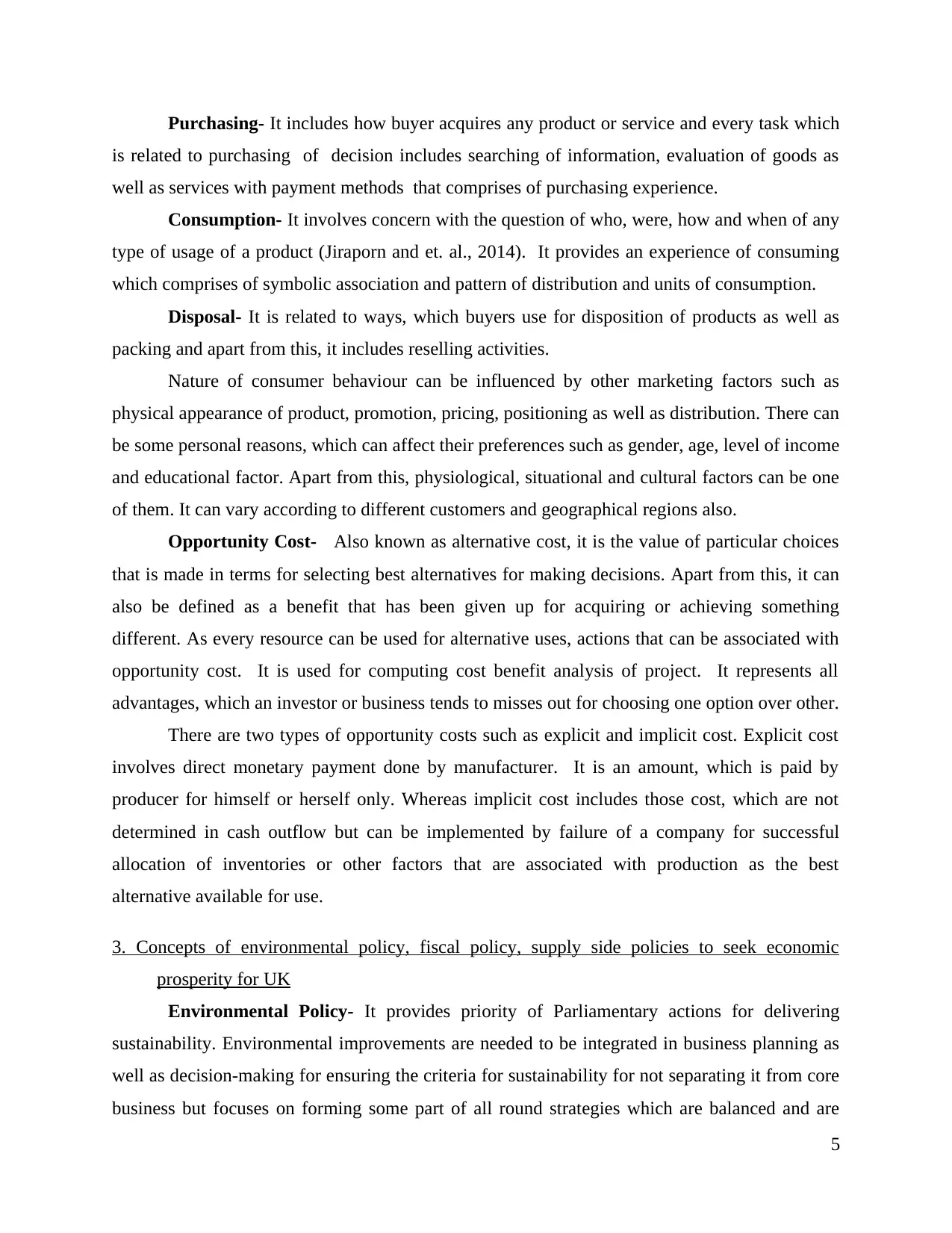
Purchasing- It includes how buyer acquires any product or service and every task which
is related to purchasing of decision includes searching of information, evaluation of goods as
well as services with payment methods that comprises of purchasing experience.
Consumption- It involves concern with the question of who, were, how and when of any
type of usage of a product (Jiraporn and et. al., 2014). It provides an experience of consuming
which comprises of symbolic association and pattern of distribution and units of consumption.
Disposal- It is related to ways, which buyers use for disposition of products as well as
packing and apart from this, it includes reselling activities.
Nature of consumer behaviour can be influenced by other marketing factors such as
physical appearance of product, promotion, pricing, positioning as well as distribution. There can
be some personal reasons, which can affect their preferences such as gender, age, level of income
and educational factor. Apart from this, physiological, situational and cultural factors can be one
of them. It can vary according to different customers and geographical regions also.
Opportunity Cost- Also known as alternative cost, it is the value of particular choices
that is made in terms for selecting best alternatives for making decisions. Apart from this, it can
also be defined as a benefit that has been given up for acquiring or achieving something
different. As every resource can be used for alternative uses, actions that can be associated with
opportunity cost. It is used for computing cost benefit analysis of project. It represents all
advantages, which an investor or business tends to misses out for choosing one option over other.
There are two types of opportunity costs such as explicit and implicit cost. Explicit cost
involves direct monetary payment done by manufacturer. It is an amount, which is paid by
producer for himself or herself only. Whereas implicit cost includes those cost, which are not
determined in cash outflow but can be implemented by failure of a company for successful
allocation of inventories or other factors that are associated with production as the best
alternative available for use.
3. Concepts of environmental policy, fiscal policy, supply side policies to seek economic
prosperity for UK
Environmental Policy- It provides priority of Parliamentary actions for delivering
sustainability. Environmental improvements are needed to be integrated in business planning as
well as decision-making for ensuring the criteria for sustainability for not separating it from core
business but focuses on forming some part of all round strategies which are balanced and are
5
is related to purchasing of decision includes searching of information, evaluation of goods as
well as services with payment methods that comprises of purchasing experience.
Consumption- It involves concern with the question of who, were, how and when of any
type of usage of a product (Jiraporn and et. al., 2014). It provides an experience of consuming
which comprises of symbolic association and pattern of distribution and units of consumption.
Disposal- It is related to ways, which buyers use for disposition of products as well as
packing and apart from this, it includes reselling activities.
Nature of consumer behaviour can be influenced by other marketing factors such as
physical appearance of product, promotion, pricing, positioning as well as distribution. There can
be some personal reasons, which can affect their preferences such as gender, age, level of income
and educational factor. Apart from this, physiological, situational and cultural factors can be one
of them. It can vary according to different customers and geographical regions also.
Opportunity Cost- Also known as alternative cost, it is the value of particular choices
that is made in terms for selecting best alternatives for making decisions. Apart from this, it can
also be defined as a benefit that has been given up for acquiring or achieving something
different. As every resource can be used for alternative uses, actions that can be associated with
opportunity cost. It is used for computing cost benefit analysis of project. It represents all
advantages, which an investor or business tends to misses out for choosing one option over other.
There are two types of opportunity costs such as explicit and implicit cost. Explicit cost
involves direct monetary payment done by manufacturer. It is an amount, which is paid by
producer for himself or herself only. Whereas implicit cost includes those cost, which are not
determined in cash outflow but can be implemented by failure of a company for successful
allocation of inventories or other factors that are associated with production as the best
alternative available for use.
3. Concepts of environmental policy, fiscal policy, supply side policies to seek economic
prosperity for UK
Environmental Policy- It provides priority of Parliamentary actions for delivering
sustainability. Environmental improvements are needed to be integrated in business planning as
well as decision-making for ensuring the criteria for sustainability for not separating it from core
business but focuses on forming some part of all round strategies which are balanced and are
5
Paraphrase This Document
Need a fresh take? Get an instant paraphrase of this document with our AI Paraphraser
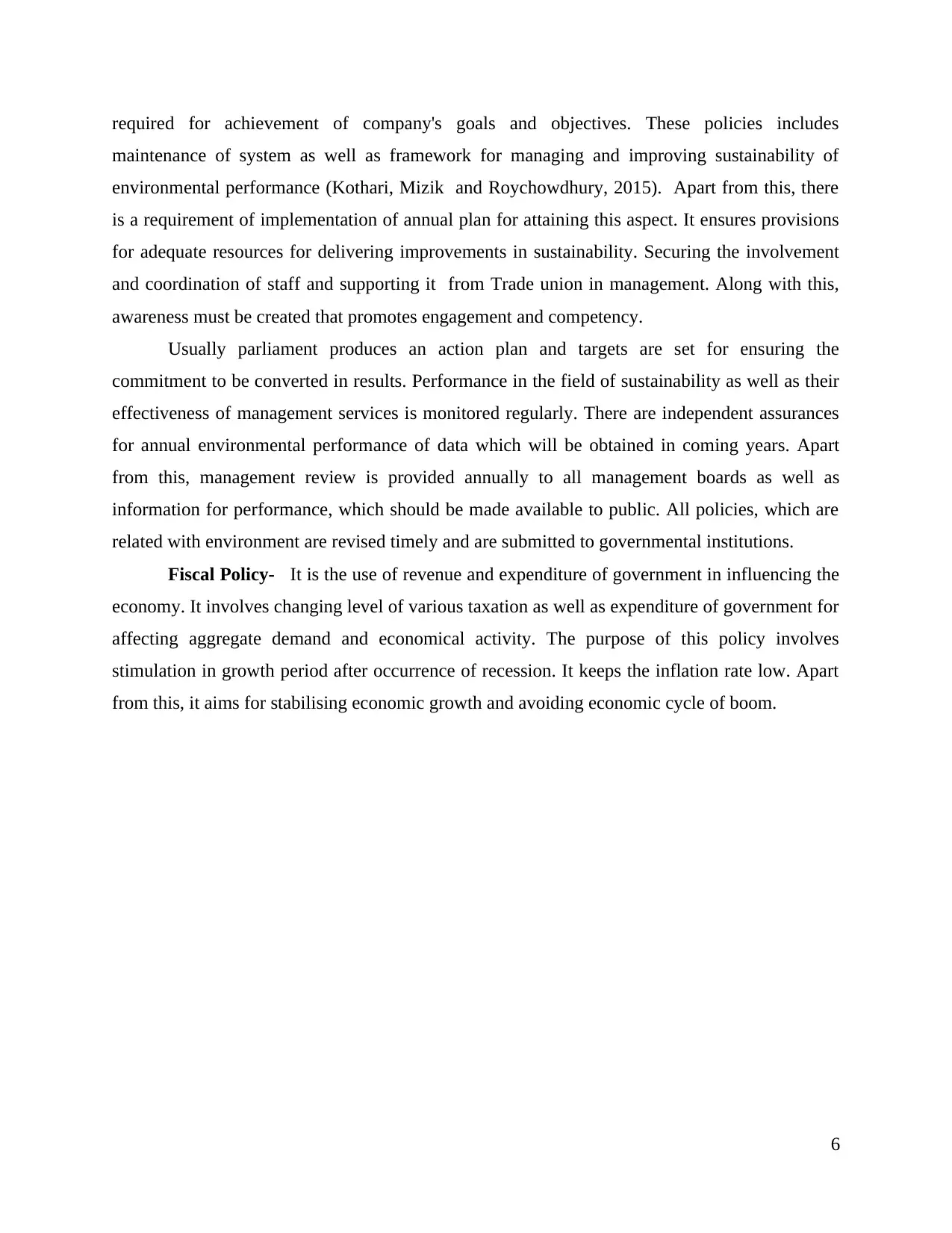
required for achievement of company's goals and objectives. These policies includes
maintenance of system as well as framework for managing and improving sustainability of
environmental performance (Kothari, Mizik and Roychowdhury, 2015). Apart from this, there
is a requirement of implementation of annual plan for attaining this aspect. It ensures provisions
for adequate resources for delivering improvements in sustainability. Securing the involvement
and coordination of staff and supporting it from Trade union in management. Along with this,
awareness must be created that promotes engagement and competency.
Usually parliament produces an action plan and targets are set for ensuring the
commitment to be converted in results. Performance in the field of sustainability as well as their
effectiveness of management services is monitored regularly. There are independent assurances
for annual environmental performance of data which will be obtained in coming years. Apart
from this, management review is provided annually to all management boards as well as
information for performance, which should be made available to public. All policies, which are
related with environment are revised timely and are submitted to governmental institutions.
Fiscal Policy- It is the use of revenue and expenditure of government in influencing the
economy. It involves changing level of various taxation as well as expenditure of government for
affecting aggregate demand and economical activity. The purpose of this policy involves
stimulation in growth period after occurrence of recession. It keeps the inflation rate low. Apart
from this, it aims for stabilising economic growth and avoiding economic cycle of boom.
6
maintenance of system as well as framework for managing and improving sustainability of
environmental performance (Kothari, Mizik and Roychowdhury, 2015). Apart from this, there
is a requirement of implementation of annual plan for attaining this aspect. It ensures provisions
for adequate resources for delivering improvements in sustainability. Securing the involvement
and coordination of staff and supporting it from Trade union in management. Along with this,
awareness must be created that promotes engagement and competency.
Usually parliament produces an action plan and targets are set for ensuring the
commitment to be converted in results. Performance in the field of sustainability as well as their
effectiveness of management services is monitored regularly. There are independent assurances
for annual environmental performance of data which will be obtained in coming years. Apart
from this, management review is provided annually to all management boards as well as
information for performance, which should be made available to public. All policies, which are
related with environment are revised timely and are submitted to governmental institutions.
Fiscal Policy- It is the use of revenue and expenditure of government in influencing the
economy. It involves changing level of various taxation as well as expenditure of government for
affecting aggregate demand and economical activity. The purpose of this policy involves
stimulation in growth period after occurrence of recession. It keeps the inflation rate low. Apart
from this, it aims for stabilising economic growth and avoiding economic cycle of boom.
6
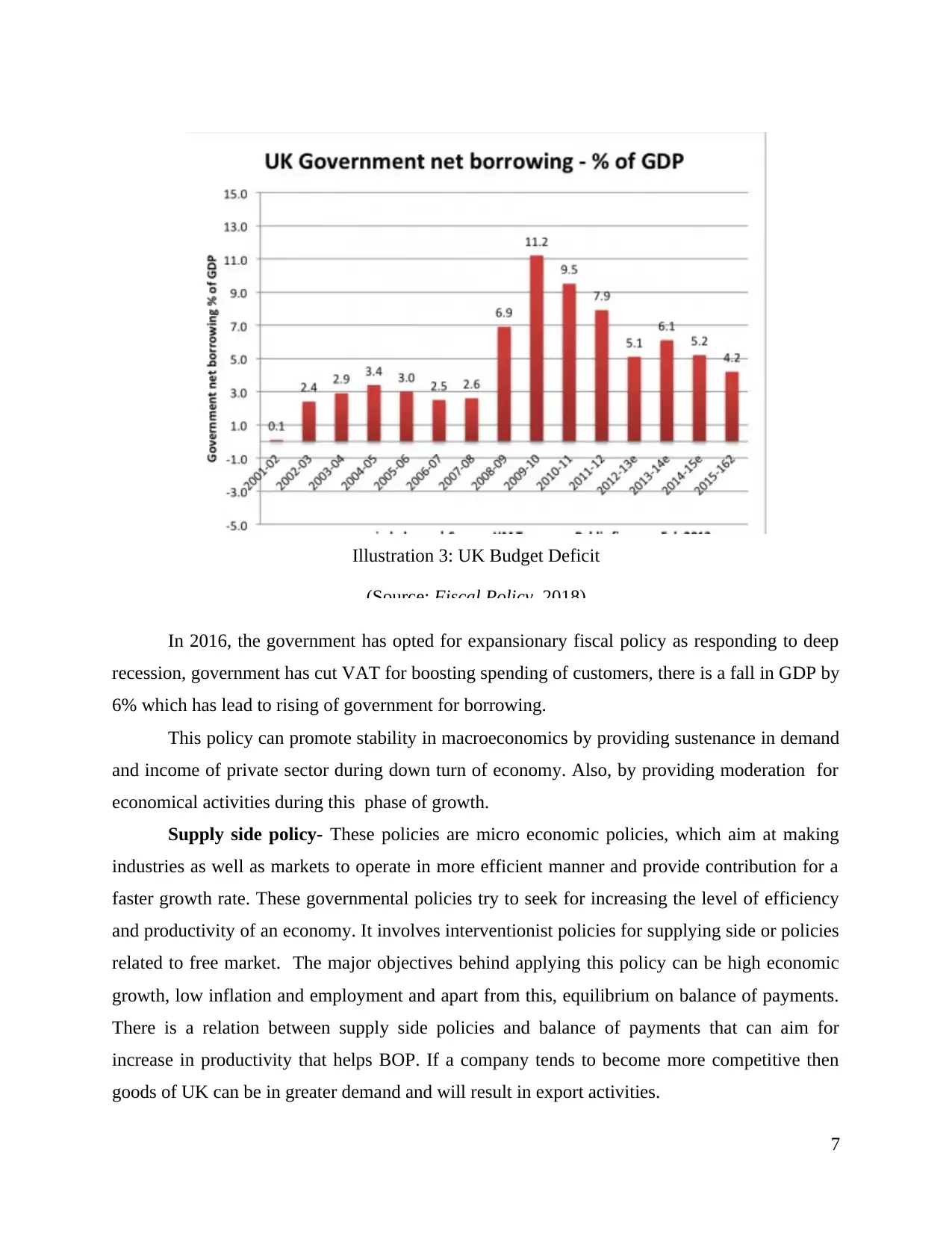
In 2016, the government has opted for expansionary fiscal policy as responding to deep
recession, government has cut VAT for boosting spending of customers, there is a fall in GDP by
6% which has lead to rising of government for borrowing.
This policy can promote stability in macroeconomics by providing sustenance in demand
and income of private sector during down turn of economy. Also, by providing moderation for
economical activities during this phase of growth.
Supply side policy- These policies are micro economic policies, which aim at making
industries as well as markets to operate in more efficient manner and provide contribution for a
faster growth rate. These governmental policies try to seek for increasing the level of efficiency
and productivity of an economy. It involves interventionist policies for supplying side or policies
related to free market. The major objectives behind applying this policy can be high economic
growth, low inflation and employment and apart from this, equilibrium on balance of payments.
There is a relation between supply side policies and balance of payments that can aim for
increase in productivity that helps BOP. If a company tends to become more competitive then
goods of UK can be in greater demand and will result in export activities.
7
Illustration 3: UK Budget Deficit
(Source: Fiscal Policy, 2018)
recession, government has cut VAT for boosting spending of customers, there is a fall in GDP by
6% which has lead to rising of government for borrowing.
This policy can promote stability in macroeconomics by providing sustenance in demand
and income of private sector during down turn of economy. Also, by providing moderation for
economical activities during this phase of growth.
Supply side policy- These policies are micro economic policies, which aim at making
industries as well as markets to operate in more efficient manner and provide contribution for a
faster growth rate. These governmental policies try to seek for increasing the level of efficiency
and productivity of an economy. It involves interventionist policies for supplying side or policies
related to free market. The major objectives behind applying this policy can be high economic
growth, low inflation and employment and apart from this, equilibrium on balance of payments.
There is a relation between supply side policies and balance of payments that can aim for
increase in productivity that helps BOP. If a company tends to become more competitive then
goods of UK can be in greater demand and will result in export activities.
7
Illustration 3: UK Budget Deficit
(Source: Fiscal Policy, 2018)
⊘ This is a preview!⊘
Do you want full access?
Subscribe today to unlock all pages.

Trusted by 1+ million students worldwide
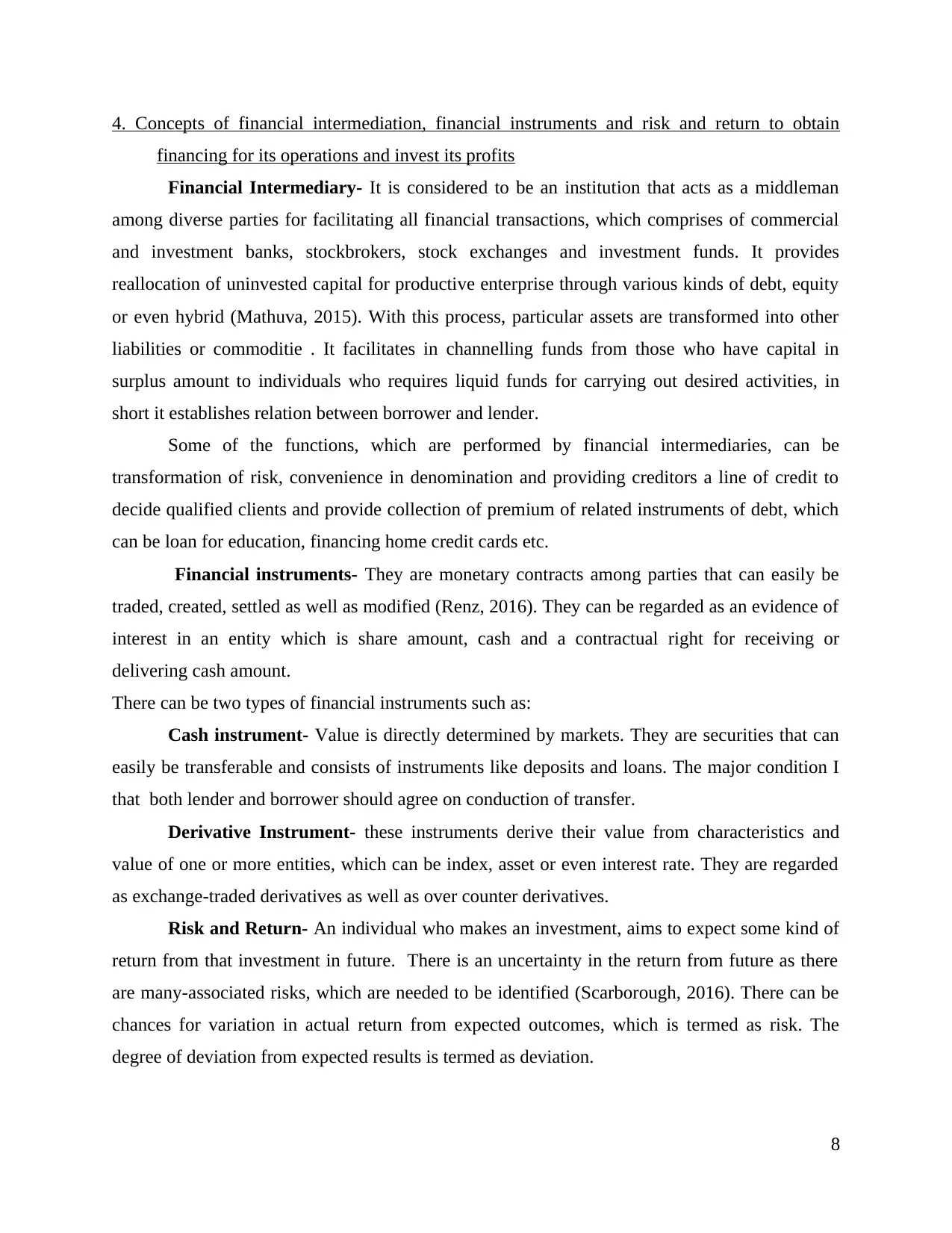
4. Concepts of financial intermediation, financial instruments and risk and return to obtain
financing for its operations and invest its profits
Financial Intermediary- It is considered to be an institution that acts as a middleman
among diverse parties for facilitating all financial transactions, which comprises of commercial
and investment banks, stockbrokers, stock exchanges and investment funds. It provides
reallocation of uninvested capital for productive enterprise through various kinds of debt, equity
or even hybrid (Mathuva, 2015). With this process, particular assets are transformed into other
liabilities or commoditie . It facilitates in channelling funds from those who have capital in
surplus amount to individuals who requires liquid funds for carrying out desired activities, in
short it establishes relation between borrower and lender.
Some of the functions, which are performed by financial intermediaries, can be
transformation of risk, convenience in denomination and providing creditors a line of credit to
decide qualified clients and provide collection of premium of related instruments of debt, which
can be loan for education, financing home credit cards etc.
Financial instruments- They are monetary contracts among parties that can easily be
traded, created, settled as well as modified (Renz, 2016). They can be regarded as an evidence of
interest in an entity which is share amount, cash and a contractual right for receiving or
delivering cash amount.
There can be two types of financial instruments such as:
Cash instrument- Value is directly determined by markets. They are securities that can
easily be transferable and consists of instruments like deposits and loans. The major condition I
that both lender and borrower should agree on conduction of transfer.
Derivative Instrument- these instruments derive their value from characteristics and
value of one or more entities, which can be index, asset or even interest rate. They are regarded
as exchange-traded derivatives as well as over counter derivatives.
Risk and Return- An individual who makes an investment, aims to expect some kind of
return from that investment in future. There is an uncertainty in the return from future as there
are many-associated risks, which are needed to be identified (Scarborough, 2016). There can be
chances for variation in actual return from expected outcomes, which is termed as risk. The
degree of deviation from expected results is termed as deviation.
8
financing for its operations and invest its profits
Financial Intermediary- It is considered to be an institution that acts as a middleman
among diverse parties for facilitating all financial transactions, which comprises of commercial
and investment banks, stockbrokers, stock exchanges and investment funds. It provides
reallocation of uninvested capital for productive enterprise through various kinds of debt, equity
or even hybrid (Mathuva, 2015). With this process, particular assets are transformed into other
liabilities or commoditie . It facilitates in channelling funds from those who have capital in
surplus amount to individuals who requires liquid funds for carrying out desired activities, in
short it establishes relation between borrower and lender.
Some of the functions, which are performed by financial intermediaries, can be
transformation of risk, convenience in denomination and providing creditors a line of credit to
decide qualified clients and provide collection of premium of related instruments of debt, which
can be loan for education, financing home credit cards etc.
Financial instruments- They are monetary contracts among parties that can easily be
traded, created, settled as well as modified (Renz, 2016). They can be regarded as an evidence of
interest in an entity which is share amount, cash and a contractual right for receiving or
delivering cash amount.
There can be two types of financial instruments such as:
Cash instrument- Value is directly determined by markets. They are securities that can
easily be transferable and consists of instruments like deposits and loans. The major condition I
that both lender and borrower should agree on conduction of transfer.
Derivative Instrument- these instruments derive their value from characteristics and
value of one or more entities, which can be index, asset or even interest rate. They are regarded
as exchange-traded derivatives as well as over counter derivatives.
Risk and Return- An individual who makes an investment, aims to expect some kind of
return from that investment in future. There is an uncertainty in the return from future as there
are many-associated risks, which are needed to be identified (Scarborough, 2016). There can be
chances for variation in actual return from expected outcomes, which is termed as risk. The
degree of deviation from expected results is termed as deviation.
8
Paraphrase This Document
Need a fresh take? Get an instant paraphrase of this document with our AI Paraphraser
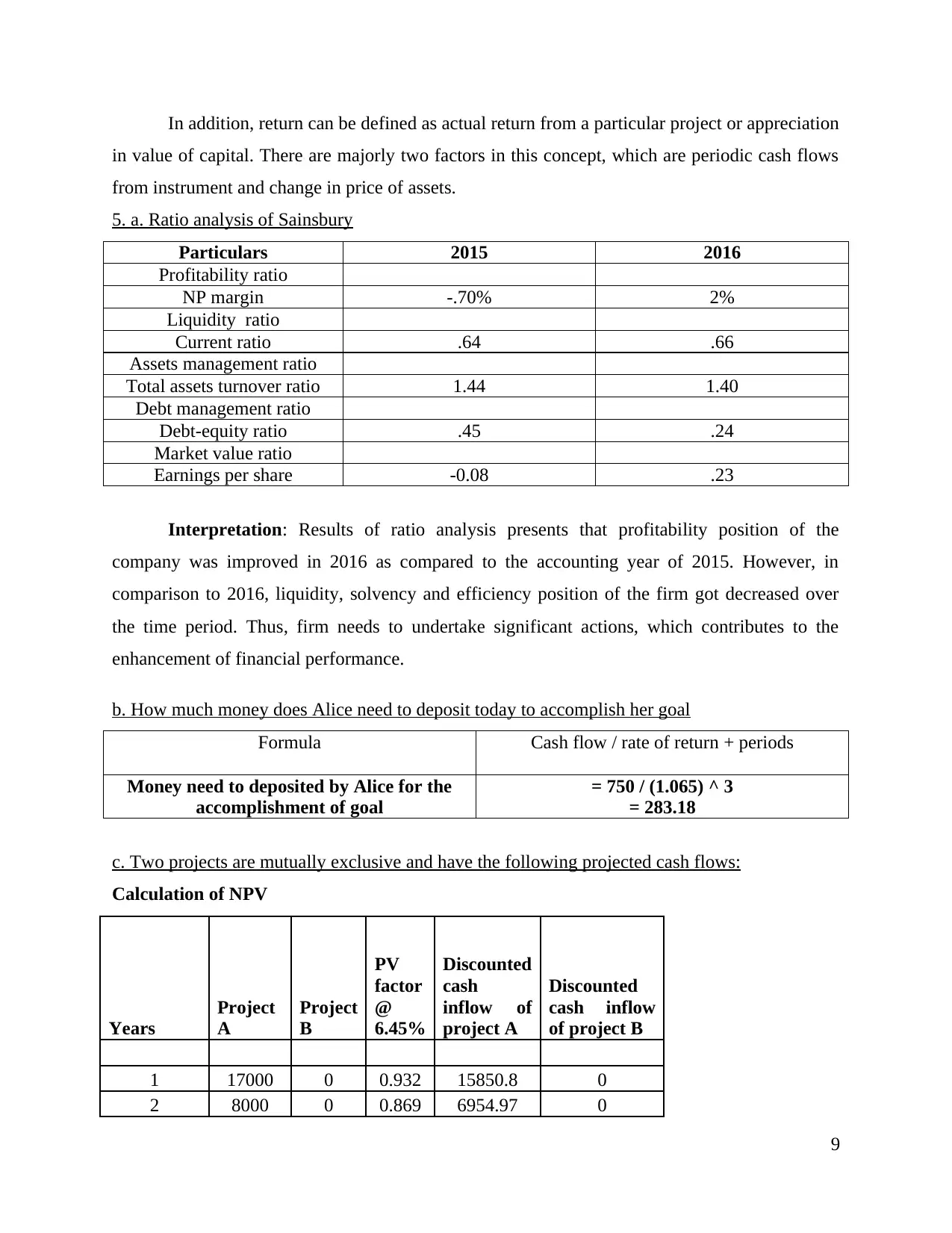
In addition, return can be defined as actual return from a particular project or appreciation
in value of capital. There are majorly two factors in this concept, which are periodic cash flows
from instrument and change in price of assets.
5. a. Ratio analysis of Sainsbury
Particulars 2015 2016
Profitability ratio
NP margin -.70% 2%
Liquidity ratio
Current ratio .64 .66
Assets management ratio
Total assets turnover ratio 1.44 1.40
Debt management ratio
Debt-equity ratio .45 .24
Market value ratio
Earnings per share -0.08 .23
Interpretation: Results of ratio analysis presents that profitability position of the
company was improved in 2016 as compared to the accounting year of 2015. However, in
comparison to 2016, liquidity, solvency and efficiency position of the firm got decreased over
the time period. Thus, firm needs to undertake significant actions, which contributes to the
enhancement of financial performance.
b. How much money does Alice need to deposit today to accomplish her goal
Formula Cash flow / rate of return + periods
Money need to deposited by Alice for the
accomplishment of goal
= 750 / (1.065) ^ 3
= 283.18
c. Two projects are mutually exclusive and have the following projected cash flows:
Calculation of NPV
Years
Project
A
Project
B
PV
factor
@
6.45%
Discounted
cash
inflow of
project A
Discounted
cash inflow
of project B
1 17000 0 0.932 15850.8 0
2 8000 0 0.869 6954.97 0
9
in value of capital. There are majorly two factors in this concept, which are periodic cash flows
from instrument and change in price of assets.
5. a. Ratio analysis of Sainsbury
Particulars 2015 2016
Profitability ratio
NP margin -.70% 2%
Liquidity ratio
Current ratio .64 .66
Assets management ratio
Total assets turnover ratio 1.44 1.40
Debt management ratio
Debt-equity ratio .45 .24
Market value ratio
Earnings per share -0.08 .23
Interpretation: Results of ratio analysis presents that profitability position of the
company was improved in 2016 as compared to the accounting year of 2015. However, in
comparison to 2016, liquidity, solvency and efficiency position of the firm got decreased over
the time period. Thus, firm needs to undertake significant actions, which contributes to the
enhancement of financial performance.
b. How much money does Alice need to deposit today to accomplish her goal
Formula Cash flow / rate of return + periods
Money need to deposited by Alice for the
accomplishment of goal
= 750 / (1.065) ^ 3
= 283.18
c. Two projects are mutually exclusive and have the following projected cash flows:
Calculation of NPV
Years
Project
A
Project
B
PV
factor
@
6.45%
Discounted
cash
inflow of
project A
Discounted
cash inflow
of project B
1 17000 0 0.932 15850.8 0
2 8000 0 0.869 6954.97 0
9
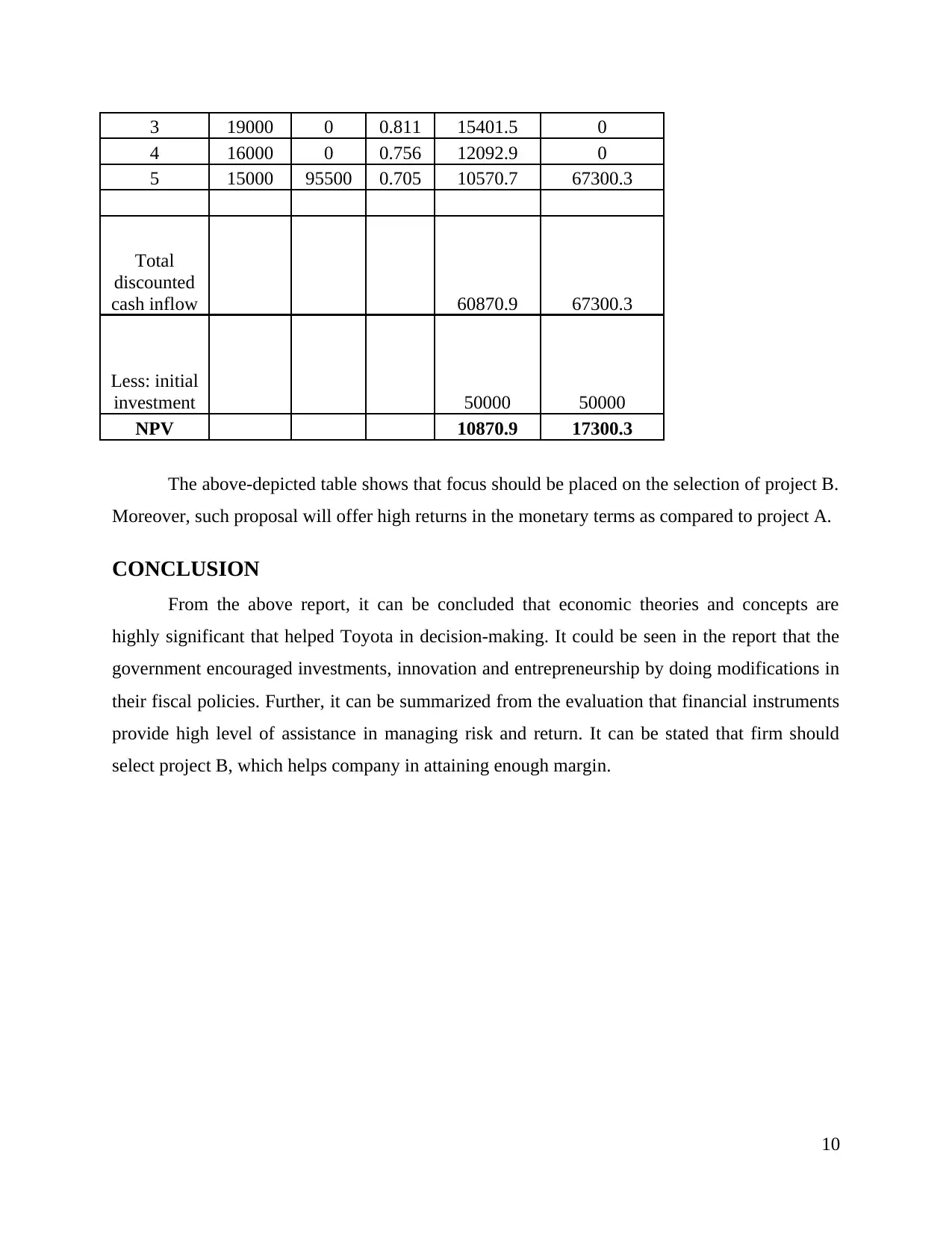
3 19000 0 0.811 15401.5 0
4 16000 0 0.756 12092.9 0
5 15000 95500 0.705 10570.7 67300.3
Total
discounted
cash inflow 60870.9 67300.3
Less: initial
investment 50000 50000
NPV 10870.9 17300.3
The above-depicted table shows that focus should be placed on the selection of project B.
Moreover, such proposal will offer high returns in the monetary terms as compared to project A.
CONCLUSION
From the above report, it can be concluded that economic theories and concepts are
highly significant that helped Toyota in decision-making. It could be seen in the report that the
government encouraged investments, innovation and entrepreneurship by doing modifications in
their fiscal policies. Further, it can be summarized from the evaluation that financial instruments
provide high level of assistance in managing risk and return. It can be stated that firm should
select project B, which helps company in attaining enough margin.
10
4 16000 0 0.756 12092.9 0
5 15000 95500 0.705 10570.7 67300.3
Total
discounted
cash inflow 60870.9 67300.3
Less: initial
investment 50000 50000
NPV 10870.9 17300.3
The above-depicted table shows that focus should be placed on the selection of project B.
Moreover, such proposal will offer high returns in the monetary terms as compared to project A.
CONCLUSION
From the above report, it can be concluded that economic theories and concepts are
highly significant that helped Toyota in decision-making. It could be seen in the report that the
government encouraged investments, innovation and entrepreneurship by doing modifications in
their fiscal policies. Further, it can be summarized from the evaluation that financial instruments
provide high level of assistance in managing risk and return. It can be stated that firm should
select project B, which helps company in attaining enough margin.
10
⊘ This is a preview!⊘
Do you want full access?
Subscribe today to unlock all pages.

Trusted by 1+ million students worldwide
1 out of 15
Related Documents
Your All-in-One AI-Powered Toolkit for Academic Success.
+13062052269
info@desklib.com
Available 24*7 on WhatsApp / Email
![[object Object]](/_next/static/media/star-bottom.7253800d.svg)
Unlock your academic potential
Copyright © 2020–2025 A2Z Services. All Rights Reserved. Developed and managed by ZUCOL.





